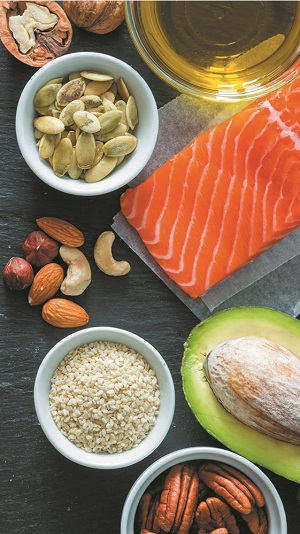Getting To The Heart Of The Fat Issue

A certain amount of healthy fat is good for your heart.
Low-fat, no-fat, fat-free. Fat has been shamed for so long, it's easy to think there's no place for it in a heart-healthy diet. But the opposite is true. "It's a myth that lowering fat intake is healthy," says Dr. Frank Sacks, professor of cardiovascular disease prevention at the Harvard T.H. Chan School of Public Health. "The key is to use more healthful unsaturated fats and less of the detrimental saturated fats."
The good and the bad
To understand the role of fat in heart health, you first have to look at where it's found in food. There are two types of fat: saturated and unsaturated.
Saturated. This "bad" fat is found in animal products like beef, pork, and dairy products such as butter, cream, and cheese. Major sources of saturated fat are fast, snack, and processed foods, such as pizza, dairy desserts, bacon, hamburgers, and cookies. If it's considered junk food, odds are it contains saturated fat.
Unsaturated. This is the healthy fat, and there are two kinds: monounsaturated and polyunsaturated.
- Monounsaturated fats are found in avocados, peanuts, and peanut butter, and tree nuts like almonds, hazelnuts, cashews, pistachios, and pecans. High amounts are also in oils, such as olive, peanut, safflower, sunflower, and canola oil.
- Polyunsaturated fats include omega-6 fatty acids and omega-3 fatty acids. They are considered essential fats because your body can't make them and you have to get them from food. Omega-6s are in oils like soybean, corn, sesame, and peanut. They're also abundant in walnuts, peanuts, pumpkin seeds, and flaxseeds. Omega-3s are in canola and soybean oil, and fish, like salmon, mackerel, herring, tuna, and trout.
Lowering your risk
How does fat help (or hurt) the heart? It has to do with lowering LDL (bad) cholesterol levels. Saturated fat raises LDL cholesterol levels. LDL cholesterol gets in the walls of arteries, causing atherosclerosis, a form of blood vessel disease that can lead to heart attacks and strokes.
"Decreasing saturated fat in your diet thus can lower your risk of heart attacks and strokes," says Dr. Sacks.
But it isn't enough to simply cut out bad fat. You need to replace it with good unsaturated fats.
Unsaturated fats are good for your heart because they help lower blood pressure and reduce triglycerides, a type of fat in your blood, which slows the buildup of plaque in arteries. In fact, a 2015 study from the nutrition department of the Harvard T.H. Chan School of Public Health and published in the Journal of the American College of Cardiology found that healthy people who switched out saturated fats in their diet for the same amounts of polyunsaturated or monounsaturated fats lowered their risk of heart disease by up to 25%.
Making this switch can also help protect against diabetes, a significant risk factor for heart disease, by improving blood glucose (sugar) levels, according to an analysis of observational studies involving almost 5,000 people, published online July 19, 2016, by PLOS Medicine.
The researchers found that switching as little as 5% of daily calories from saturated fats to unsaturated fats lowered average glucose levels enough to reduce the incidence of type 2 diabetes by 22% and cardiovascular disease by 6.8%.
Trans fats: Going, going, almost gone
The worst type of fat is trans fat, which has been shown to raise LDL cholesterol levels. Trans fats are found (typically in the form of partially hydrogenated oil) in many common baked goods like crackers, cookies, cakes, biscuits, and rolls, as well as in other snack foods and fast foods. However, they have become less of a health concern since the FDA pressured food manufacturers to eliminate them. They are nearly gone from most food products, but always check the Nutrition Facts panel on the label to be safe. Be aware that even if the label says zero grams of trans fat per serving, there still may be up to 0.5 grams.
Reduce and replace
So how much fat is enough? The American Heart Association doesn't recommend a specific amount or limit of fat intake, so the best way to manage fat in your diet is to take this two-step approach, says Dr. Sacks:
- Cut out saturated fat, or keep intake to a minimum as much as possible.
- Add healthy polyunsaturated and monounsaturated fats to your daily diet as much as possible.
Another upside to healthy fats is you don't need much to improve heart health. You can get what you need by adding small amounts to everyday meals and cooking methods, says Dr. Sacks.
For instance, instead of using butter whenever you bake or sauté, substitute olive oil, peanut oil, corn oil, or another unsaturated oil, according to your taste. Drizzle these oils on salads and sides in place of salad dressing, butter, or sour cream. Replace red meat with fish, spread avocado or nut butter instead of butter on toast, and use palm-size servings of nuts and seeds for snacks. "This way you don't have to radically change your diet, but rather just adjust it," says Dr. Sacks.
Fat equals weight gain? Not so fast
Another risk factor for heart disease is weight gain, but cutting out fat is not the secret to cutting pounds, according to Dr. Sacks. "Eating fat doesn't make you fat. Excess calories can come from fatty or high-carbohydrate foods, including added sugars, and that is what you need to be careful about," he says. "Your body doesn't care where the calories come from in term of weight gain — protein, carbs, fats — it's all the same."
Story Credit: https://www.health.harvard.edu/mens-health/getting-to-the-heart-of-the-fat-issue


